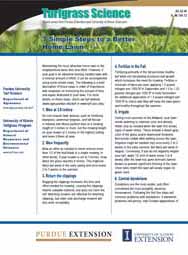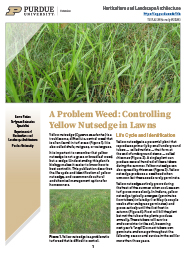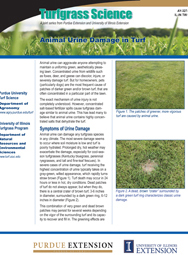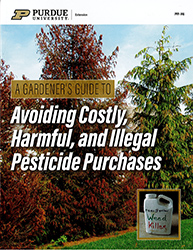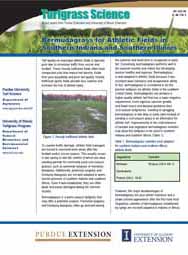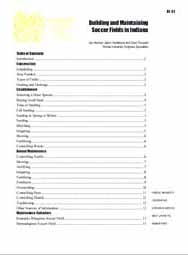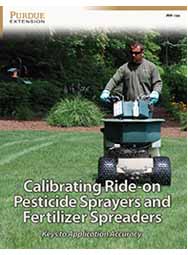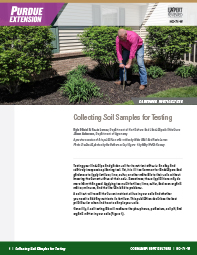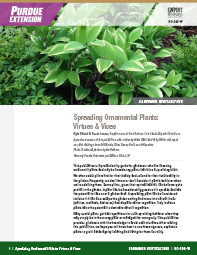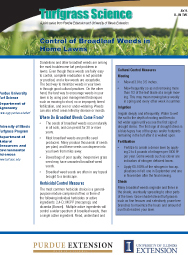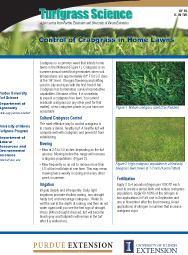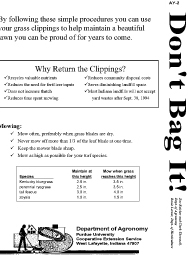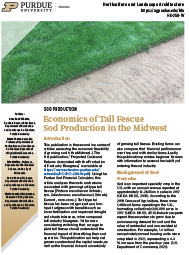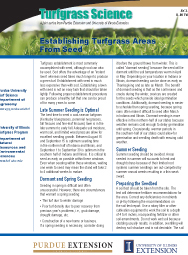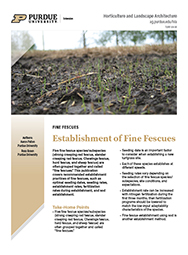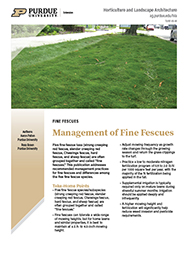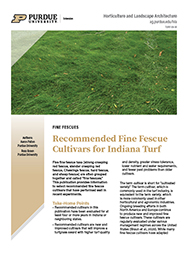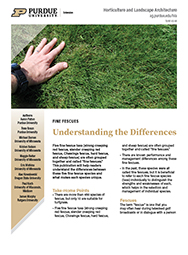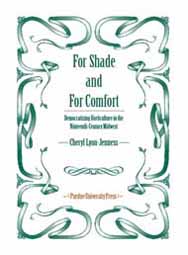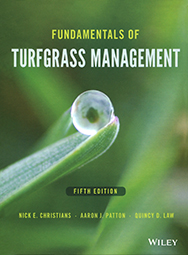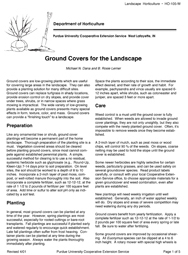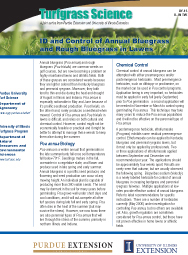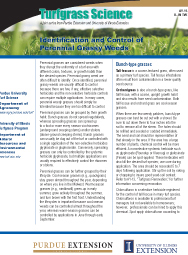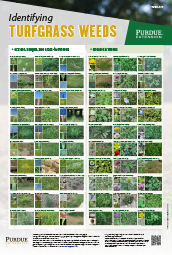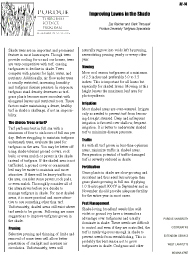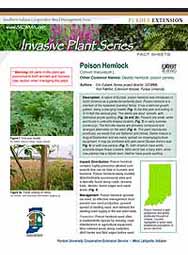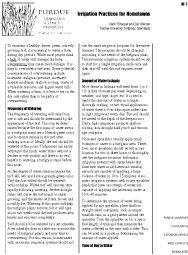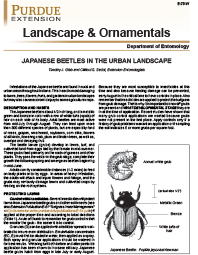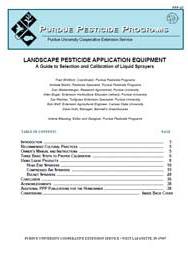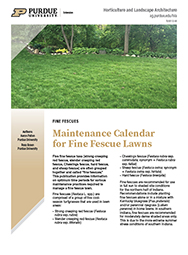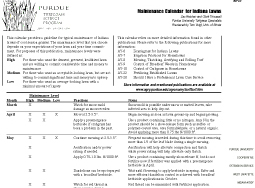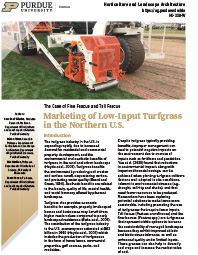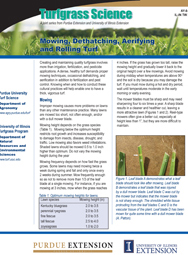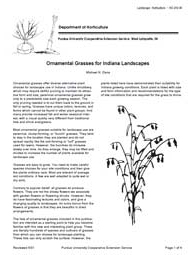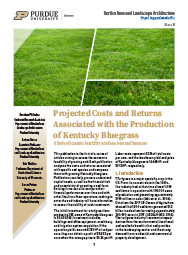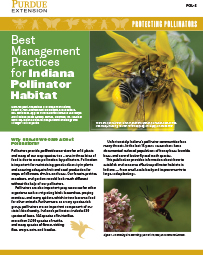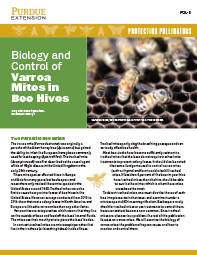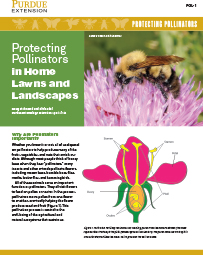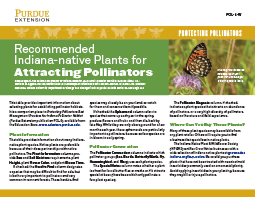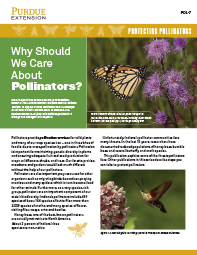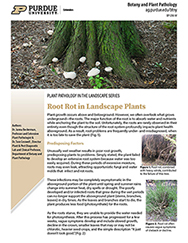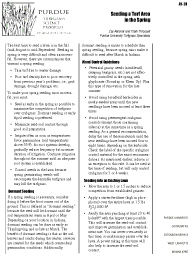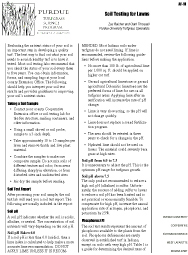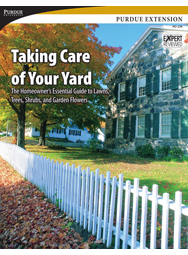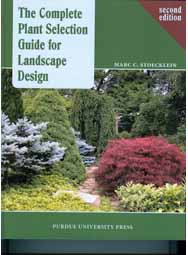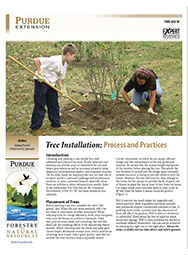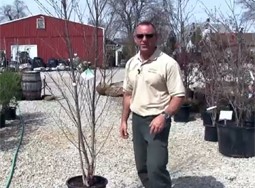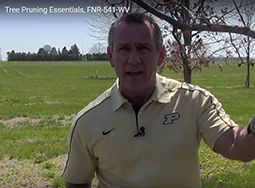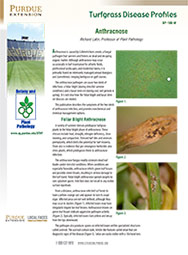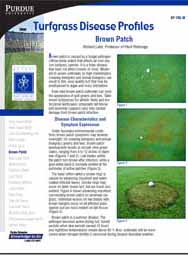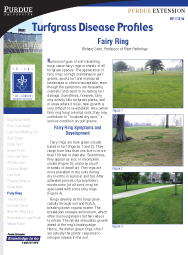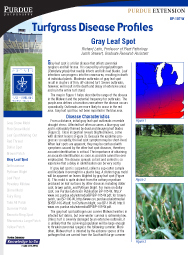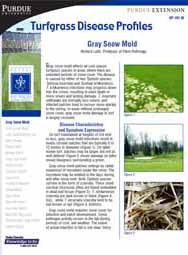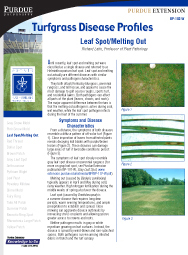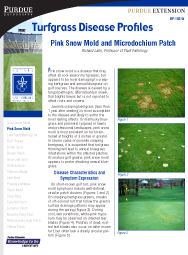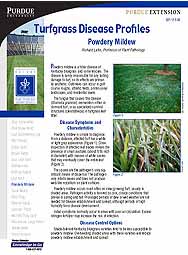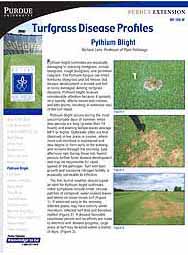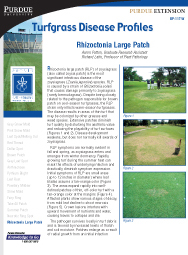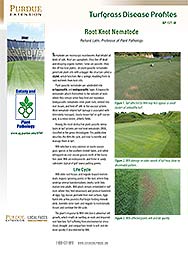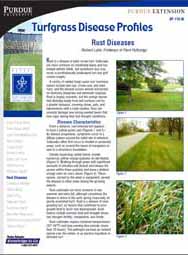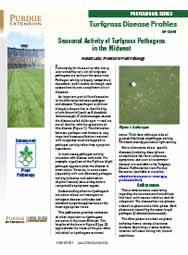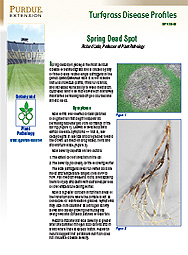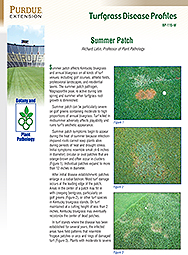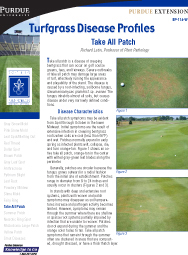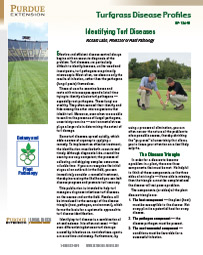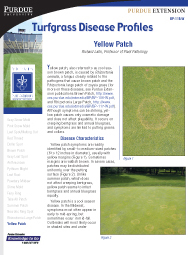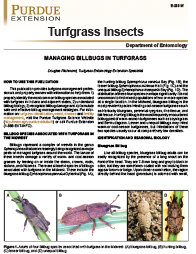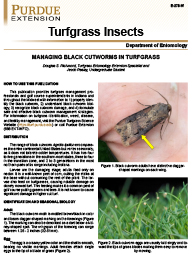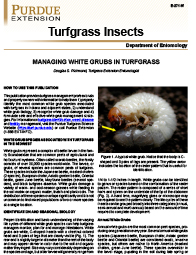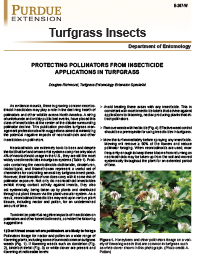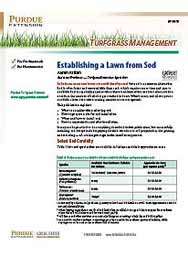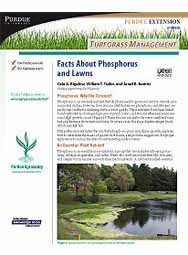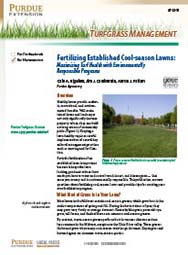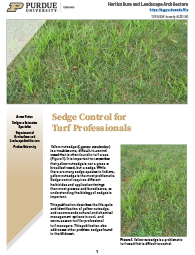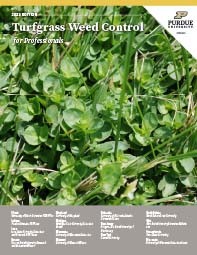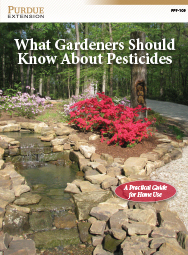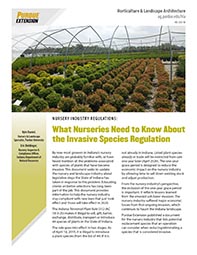Home & Family
Lawn & Turf
7 Simple Steps to a Better Homelawn
Maintaining the most attractive homelawn in the neighborhood takes time and effort. However, if your goal is a good-looking, healthy lawn with a minimal amount of effort, it can be accomplished using some simple steps. ...
A problem weed: Controlling yellow nutsedge in lawns
This publication, formerly AY-19-W and updated in July 2021, describes the life cycle and identification of yellow nutsedge and recommends cultural and chemical management options for homeowners. A similar publication, T...
Animal urine can aggravate anyone attempting to maintain a uniformly green, aesthetically pleasing lawn. For homeowners, pets (particularly dogs) are the most frequent cause of patches of darker green and/or brown turf, ...
This publication provides a general guide to taking care of plants within the home, yard, lawn, and garden during the autumn months. ...
Avoiding Costly, Harmful, and Illegal Pesticide Purchases
Many homeowners struggle with maintaining their lawns, flower and vegetable gardens, landscapes, wooded areas, and water features. Insects and diseases are an occasional nuisance, but weeds are a constant problem. Despit...
Bermudagrass for Southern Indiana Athletic Fields
Turf quality on municipal athletic fields in southern Indiana is typically poor due to excessive traffic from football and soccer. But reseeding worn areas with some common grass varieties in late spring or late fall are...
Building and Maintaining Soccer Fields in Indiana
Soccer fields are the toughest of all turf areas to manage. This publication highlights several principles of construction and maintenance to help produce a soccer field with good playability and emphasis on player safet...
Calibrating Ride-on Pesticide Sprayers and Fertilizer Spreaders: Keys to Application Accuracy
This publication addresses specific procedures for separately calibrating the pesticide sprayer and the fertilizer spreader of ride-on equipment. The goal is to ensure proper application to optimize performance.
Consumer Horticulture: Collecting Soil Samples for Testing
A soil test will reveal the current nutrient status in your soils and whether you need to add any nutrients as fertilizer. This publication describes the best practices for when and how to sample your soils.
...Consumer Horticulture: Fertilizing Woody Plants
This publication examines the basics of why and how to fertilize woody plants in the home landscape.
Format: PDF
Pages: 10
Language: Engl...
Consumer Horticulture: Spreading Ornamental Plants: Virtues & Vices
This publication is a precautionary guide for gardeners who are choosing ornamental plants and may be considering plants that have a spreading habit. Formerly Purdue Extension publication HLA-1-W
Format...
Control of Broadleaf Weeds in Home Lawns
This publication suggests herbicides and application schedules for controlling broadleaf weeds in the lawn and describes summer lawn care management practices for controlling broadleaf weeds....
Control of Crabgrass in Home Lawns
This publication provides a series of suggestions for the non-herbicidal and herbicidal control of crabgrasses and several other annual grasses including foxtail, goose grass, and barnyard grass....
How can you handle grass clippings when the city is not going to collect them any more? AY-2 offers tips on how to leave grass clippings on the lawn while maintaining a healthy yard....
Economics of Tall Fescue Sod Production in the Midwest
This publication uses the Purdue Sod Financial Calculator to analyze the costs and returns associated with growing turf-type tall fescue. It helps sod growers understand capital needs as well as financial risks. Pairs wi...
Establishing Turfgrass Areas From Seed
This provides guidelines for establishng lawns from seed rather than from sod. It includes information on variety selection, seedbed preparation, watering, and weed control for newly established turfgrass areas....
Fine Fescues - Establishment of Fine Fescues
Two Purdue experts discuss recommended establishment practices of five fine fescue species/subspecies (strong creeping red fescue, slender creeping red fescue, Chewings fescue, hard fescue, and sheep fescue) that are oft...
Fine Fescues - Fine Fescues in Minimal to no-Mow Areas
Some fine fescues are used in minimal-to-no-mow naturalized areas. This publication, by experts at five universities, covers recommended establishment, management practices and subtle differences among five species/subsp...
Fine Fescues - Management of Fine Fescues
In this publication, part of a series, two Purdue experts address recommended management practices and differences among five fine fescue species: strong creeping red fescue, slender creeping red fescue, Chewings fescue,...
Fine Fescues - Recommended Fine Fescue Cultivars for Indiana Turf
Which cultivar should you choose? This publication, by two Purdue experts, looks at five fine fescue cultivars that have been evaluated for four or more years in Indiana or neighboring states. For more in this series, se...
Fine Fescues - Understanding the Differences
Five fine fescue taxa (strong creeping red fescue, slender creeping red fescue, Chewings fescue, hard fescue, and sheep fescue) are often grouped together and called "fine fescues." In this publication, part of a series,...
For Shade and For Comfort: Democratizing Horticulture in the Nineteenth-Century Midwest (hardback)
Between 1850 and 1880, Americans of all ranks and circumstances planted shade trees, cultivated flower gardens, and established lawns with a new-found enthusiasm that both astonished and delighted horticultural advocates...
Fundamentals of Turfgrass Management
Fundamentals of Turfgrass Management is the bestselling guide with expert coverage of basic turfgrass science and all aspects of practical care. Now in its fifth edition, this industry favorite offers the lates...
Ground Covers for the Landscape
This publication discusses the preparation, planting, and care for ground covers. The various ground covers are itemized according to their specific uses. ...
ID and Control of Annual Bluegrass and Rough Bluegrass in Lawns
Controlling annual bluegrass (Poa annua) and rough bluegrass (Poa trivialis) in lawns is difficult, and relies on both cultural and chemical control. This publication describes these weeds and offers management strategi...
Identification and Control of Perennial Grassy Weeds
This publication describes how to identify and control the two main categories of perennial grassy weeds: bunch-type and spreading grasses....
Identifying Turfgrass Weeds Poster
**IMPORTANT; PLEASE READ PRIOR TO ORDERING - Due to varying costs based on shipping location, the shipping fees for this item will be determined on an individual basis. Shipping totals include the ACTUAL shipping amou...
Identifying Turfgrass Weeds Poster - 5 pack
**IMPORTANT; PLEASE READ PRIOR TO ORDERING - Due to varying costs based on shipping location, the shipping fees for this item will be determined on an individual basis. Shipping totals include the ACTUAL shipping amou...
Information in this publication provides a series of suggestions on fertilization, pest control, and general maintenance for improving the health of turfgrasses growing in shaded areas....
Invasive Plant Species Fact Sheets: Poison Hemlock
This threepage fact sheet in the Invasive Plant Series provides information on identifying and controlling this poisonous weed. The publication, produced in partnership with the Southern Indiana Cooperative Weed Manageme...
Irrigation Practices for Homelawns
This publication discusses several irrigation practices for homelawns such as frequency of watering, time of day to water, and rate of application....
Landscape & Ornamentals: Japanese Beetles in the Urban Landscape
Japanese beetle infestations are found in rural and urban areas throughout Indiana. This publication describes Japanese beetle habits and how to control them in lawns, ornamentals, and food plants.
Forma...
Landscape Pesticide Application Equipment: A Guide to Selection and Calibration of Liquid Sprayers
Homeowners strive for beautiful and productive lawns, and sometimes, despite using good cultural practices, pests get the upper hand. When using pesticides to control pests it's important to follow procedures and know ho...
This publication provides suggestions on sodding and restarting a new lawn. In addition, it gives ideas for maintaining the lawn, a turf care sequence and sample sod specifications....
Maintenance Calendar for Fine Fescue Lawns
Five fine fescue taxa (strong creeping red fescue, slender creeping red fescue, Chewings fescue, hard fescue, and sheep fescue) are often grouped together and called "fine fescues." In this publication, part of a series,...
Maintenance Calendar for Indiana Lawns
The "Maintenance Calendar" provides seasonal lawn tips for cool season grasses. Three maintenance levels are established depending on the amount of money and time you are willing to invest. The calendar provides practice...
Marketing of Low-Input Turfgrass in the Northern US
Using data from a web-based survey of sod buyers, Purdue researchers investigate marketing opportunities and barriers for fine fescue and tall fescue sod. Their conclusions include the importance of the role that sod gro...
Mowing, Thatching, Aerifying, and Rolling Turf
A publication that gives suggestions for maintaining turf by effective mowing, thatching and aerifying....
Ornamental Grasses for Indiana Landscapes
This publication includes lists of ornamental grasses intended as a starting point to help you become familiar with ornamental grasses. ...
Possum in the Pawpaw Tree: A Seasonal Guide to Midwestern Gardening (Paperback)
Inspired by actual gardeners' inquiries, each chapter deals with such down-to-earth subjects as when to start seeds, why plants might fail to bloom, pruning techniques, identifying and controlling common pests, home f...
Projected Costs and Returns Associated with the Production of Kentucky Bluegrass
Turfgrass is a major specialty crop in the US. In the Midwest, production has been dominated by Kentucky bluegrass. This publication, the first in a forthcoming series, uses data from Indiana and Iowa to assess the econo...
Protecting Pollinators: Best Management Practices for Indiana Pollinator Habitat
This publication provides information about how to establish and conserve effective pollinator habitats in Indiana - from small-scale backyard improvements to large-scale plantings.
Format: Bo...
Protecting Pollinators: Biology and Control of Varroa Mites in Bee Hives
This publication describes varroa mites and their effects on honey bee hives. It also recommends monitoring and management practices to protect hives against this pest.
Format: Booklet, PDF, an...
Protecting Pollinators: Protecting Pollinators in Home Lawns and Landscapes
Whether you know it or not, we all depend on pollinators for the fruits, vegetables, nuts, and flowers that enrich our lives. But pollinators face many threats. This publication explains what homeowners can do to prot...
Protecting Pollinators: Recommended Indiana-native Plants for Attracting Pollinators
This publication provides a list of recommended plants that homeowners and others can use to establish and conserve effective pollinator habitats in Indiana - from small-scale backyard improvements to large-scale plan...
Protecting Pollinators: Why Should We Care About Pollinators?
This publication explains some of the threats pollinators face. Other publications in the Protecting Pollinators series describe steps you can take to protect pollinators.
Format: Booklet, PDF,...
Purchasing Quality Grass Seed for Your Lawn
This publication provides help when selecting turfgrass for different lawns. Things to look for on a bag of quality grass seed are also covered. It also defines key terms that are used with planting and maintaining tur...
Purdue Turf Doctor app for Android
The Purdue Turf Doctor app was developed by experts at Purdue University to help homeowners and land managers diagnose and address turfgrass problems caused by a variety of factors including weeds, insects, diseases, ...
Purdue Turf Doctor app for Apple iOS
The Purdue Turf Doctor app was developed by experts at Purdue University to help homeowners and land managers diagnose and address turfgrass problems caused by a variety of factors including weeds, insects, diseases, ...
Root problems in plants are frequently under- and misdiagnosed. Sometimes it's too late to save the plant. This publication, part of the Plant Pathology in the Landscape series, discusses predisposing factors, diagnosis,...
Seeding a Turf Area in the Spring
This publication provides turf seeding guidelines in the spring for established turf areas and new turf areas....
Should I Hire a Professional Lawn Care Service?
This publication addresses the advantages of hiring a professional lawn care service. It also discusses what to look for in a lawn care service and what you can do to help the lawn care service make your yard look better...
This publication is intended to aid in interpreting soil test results and to provide guidelines on improving soil nutrient status for general turf, commercial and athletic turf, and to home lawn owners....
This guide is aimed at homeowners who just want to know the basics of yard care. The guide covers tasks you should do now if your plants are new, basic care for established plants, techniques for adding new plants to you...
The Complete Plant Selection Guide for Landscape Design
In this paperback, 750-page book, the author has created a quick and easy-to-use reference guide for choosing plant material for landscape designs. This reference manual includes comprehensive lists with search criteria ...
This publication, which is part of the Protecting Pollinators series, explains the complex biology of honey bees. It also explores the roles pesticides may play in bee health, examines the latest knowledge in this fas...
Tree Installation: Process and Practices
Choosing and planting a tree should be a well-informed and planned decision. Proper selection and planting of urban trees can provide years of enjoyment for you and future generations as well as increased property val...
Tree Planting Part 1: Choosing a Tree
Choosing and planting a tree should be a well-informed and planned decision. Proper selection and planting of urban trees can provide years of enjoyment for you and future generations as well as increased property value,...
Tree Planting Part 2: Planting Your Tree
Trees and all forestlands are major assets to our cities, towns, and communities. Urban trees, in particular, provide aesthetic, functional, and environmental benefits to improve the quality of life. A well-planted an...
Pruning has been called "one of the best, worst maintenance practices" performed on trees. The process creates wounds, which have a major impact on plant processes. Improper cutting on a tree causes severe damage or even...
Pruning has been called "one of the best, worst maintenance practices," especially when performed on urban trees. The process creates wounds, which have a major impact on plant processes. Improper cutting on a tree cause...
Turfgrass Disease Profiles: Anthracnose
Anthracnose is caused by a fungus that survives and thrives on dead and decaying organic matter, and is primarily a disease of intensively managed annual bluegrass and creeping bentgrass used on golf courses. This public...
Turfgrass Disease Profiles: Brown Patch
Brown patch is caused by a fungal pathogen that affects all cool-season turfgrass species. Moderate to severe outbreaks on high-maintenance creeping bentgrass and annual bluegrass can result in thin, poor quality turf th...
Turfgrass Disease Profiles: Dollar Spot
Dollar spot is caused by a fungal pathogen and is a common concern on golf course turf, especially creeping bentgrass and annual bluegrass greens, tees, and fairways, where it can result in poor turf quality and appearan...
Turfgrass Disease Profiles: Fairy Ring
Fairy rings are dark green circular bands in turf caused by numerous soil-inhabiting fungi. This publication describes the symptoms and development of fairy rings, and provides management options....
Turfgrass Disease Profiles: Gray Leaf Spot
Gray leaf spot is a foliar disease that affects perennial ryegrass and tall fescue. Moderate outbreaks of gray leaf spot result in clusters of thin, off-colored turf. Severe outbreaks, however, will result in the death a...
Turfgrass Disease Profiles: Gray Snow Mold
Gray snow mold affects all cool season turfgrass species in areas where there are extended periods of snow cover. This publication discusses how to identify gray snow mold, and examines options for controlling the diseas...
Turfgrass Disease Profiles: Leaf Spot/Melting Out
Leaf spot and melting out are different diseases with similar symptoms and pathogen characteristics. They both attack Kentucky bluegrass, perennial ryegrass, and tall fescue, and appear to cause the most damage to golf c...
Turfgrass Disease Profiles: Necrotic Ring Spot
Necrotic ring spot infects the roots of Kentucky bluegrass on golf courses, sports turf, professional landscapes, and home lawns. It is seldom a devastating disease, but outbreaks can disturb the appearance of the turf s...
Turfgrass Disease Profiles: Pink Snow Mold and Microdochium Patch
Pink snow mold, sometimes knows as Microdochium patch, affects cool season grasses. The publication provides information on characteristics of the disease and disease control options....
Turfgrass Disease Profiles: Powdery Mildew
Powdery mildew is a foliar disease of Kentucky bluegrass and some fescues. The disease is rarely responsible for any lasting damage to turf, so its effects are primarily aesthetic. This publication describes the symptoms...
Turfgrass Disease Profiles: Pythium Blight
Pythium blight can cause considerable turf damage because it spreads quickly and affects the leaves and crowns. Pythium blight occurs during hot, humid days in the summer. This publication provides control and prevention...
Turfgrass Disease Profiles: Red Thread
Red thread is a foliar disease that usually occurs on taller mown turfgrasses during spring and fall. The disease is often associated with malnourished, low quality, slow growing turf, but the effects of the disease are ...
Turfgrass Disease Profiles: Rhizoctonia Large Patch
Rhizoctonia large patch of zoysiagrass (also called zoysia patch) is the most significant infectious disease of the zoysiagrass species. This publication shows how to identify and manage this turfgrass disease....
Turfgrass Disease Profiles: Root Knot Nematode
This publication describes the root knot nematode life cycle, and how to identify and manage them in turf.
Format: PDF.
Pages: 2.
Language: English.
...Turfgrass Disease Profiles: Rust Diseases
Leaf rust outbreaks are most common on residential lawns and low budget athletic fields. It is largely a cosmetic disease, but its orange spores can be a greater nuisance. This publication describes the symptoms and deve...
Turfgrass Disease Profiles: Seasonal Activity of Turfgrass Pathogens
Understanding when turf pathogens are active allows turf managers to anticipate disease outbreaks and schedule fungicide applications at the most appropriate times. This publication provides estimates of when important t...
Turfgrass Disease Profiles: Slime Molds
Despite their threatening appearance, slime molds are not infectious and will not result in anything more than temporary cosmetic damage. This publication describes the symptoms and signs of slime molds and control metho...
Turfgrass Disease Profiles: Smut Diseases
Smut diseases, caused by several closely related and highly specialized pathogenic fungi, tend to occur on higher cut turf, so they are often found on residential turf, athletic fields, and golf course roughs. This publi...
Turfgrass Disease Profiles: Spring Dead Spot
Spring dead spot (SDS) is the most serious disease of bermudagrass. It is a root disease that kills individual plants, thins turf stands, and increases vulnerability to weed infestation. This publication describes the sy...
Turfgrass Disease Profiles: Summer Patch
Summer patch affects Kentucky bluegrass and annual bluegrass on all kinds of turf venues, including golf courses, athletic fields, professional landscapes, and residential lawns. This publication describes summer patc...
Turfgrass Disease Profiles: Take All Patch
Take all patch is a disease of creeping bentgrass that can occur on golf course greens, tees, and fairways. This publication describes take all patch symptoms and discusses a variety of management options.
Turfgrass Disease Profiles: Turf Disease Identification
This publication will help turf managers know what to look for when they diagnose infectious turf diseases on the course and in the field. Readers will understand the components of the disease triangle (host, pathogen, a...
Turfgrass Disease Profiles: Yellow Patch
Yellow patch, also referred to as cool season brown patch, occurs on creeping bentgrass and annual bluegrass. This publication describes yellow patch symptoms and options for controlling the disease....
This publication provides property owners and turfgrass management professionals with basic information to: (1) properly identify the most common turfgrass insect pests of Indiana and adjacent states, (2) recognize inse...
Turfgrass Insects: Managing Billbugs in Turfgrass
This publication provides turfgrass management professionals and property owners with information to help them (1) properly identify the most common billbug species with turfgrass in Indiana and adjacent states, (2) unde...
Turfgrass Insects: Managing Black Cutworms in Turfgrass
This publication provides Indiana turfgrass management professionals and golf course superintendents with information to help them (1) properly identify black cutworm, (2) understand black cutworm biology, (3) recognize ...
Turfgrass Insects: Managing White Grubs in Turfgrass
This publication provides Indiana turfgrass management professionals and property owners with information to help them (1) properly identify the most common white grub species, (2) understand white grub biology, (3) reco...
Turfgrass Insects: Protecting Pollinators from Insecticide Applications in Turfgrass
This publication provides turfgrass management professionals with suggestions aimed at minimizing the potential negative impacts of neonicotinoids and other insecticides on pollinators.
Format: PDF.
Turfgrass Management: Establishing a Lawn From Sod
This publication for both professionals and homeowners explains what to consider when selecting sod, how to prepare a site for sod installation, when and how to install sod, and how to maintain the sod after installation...
Turfgrass Management: Facts About Phosphorus and Lawns
This publication for both professionals and homeowners examines the role that phosphorus plays in turfgrass growth, explains how to determine the needs of specific turf stands, and provides suggestions for proper applica...
Turfgrass Management: Fertilizing Established Cool-season Lawns
Fertilizing established lawns keeps the lawn looking good and reduces how much you have to water and control weed, insect, and disease pests — that saves you money and is environmentally responsible. This publicati...
Turfgrass Management: Sedge Control for Turf Professionals
This publication, formerly AY-338-W and updated in July 2021, describes the life cycle and identification of yellow nutsedge, and recommends cultural and chemical management options in cool- and warm-season turf for prof...
Turfgrass Weed Control for Professionals 2023 Edition (PDF Format)
THIS ITEM IS READ ONLY AND CANNOT BE PRINTED. This updated guide provides weed identification and control information that turfgrass professionals can use to develop effective weed control programs for golf courses, a...
Turfgrass Weed Control for Professionals 2023 Edition - Box of 25
This updated guide provides weed identification and control information that turfgrass professionals can use to develop effective weed control programs for golf courses, athletic fields, sod farms, lawns, and other turfg...
Turfgrass Weed Control for Professionals 2023 Edition - Combo Pack (Single Print Copy & PDF)
THIS LISTING IS FOR A SINGLE HARD COPY AND A DIGITAL DOWNLOAD
This updated guide provides weed identification and control information that turfgrass professionals can use to develop effective weed control progra...
Turfgrass Weed Control for Professionals 2023 Edition - Single Copy
This updated guide provides weed identification and control information that turfgrass professionals can use to develop effective weed control programs for golf courses, athletic fields, sod farms, lawns, and other turfg...
What Gardeners Need to Know About Pesticides
Effective pest control in the landscape and garden requires more than just spraying away the problem. Successful gardeners understand that managing insects, weeds, diseases, and vertebrate pests starts with selecting, pl...
What Nurseries Need to Know About the Invasive Species Regulation
This publication, by Purdue University and the Indiana Department of Natural Resources, informs the nursery and landscape industry about new state regulations regarding invasive plant species. The rules are effective ...
Zoysiagrass for Turfgrass Areas in Indiana
This publication provides suggestions on establishing and maintaining midwestern lawns composed of zoysia and bermuda grass....









